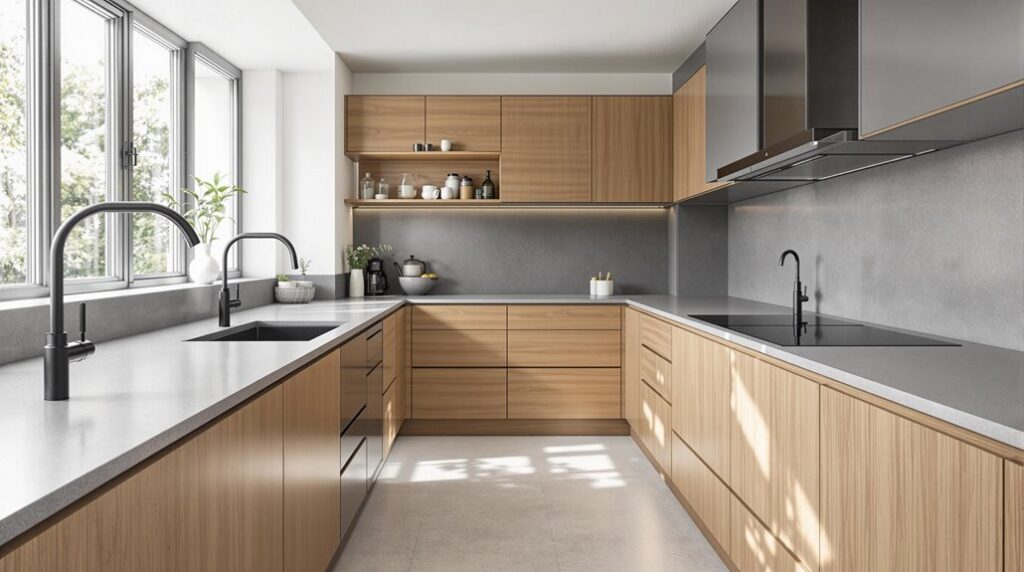I’ve been watching micro cement transform UK renovation projects for years, and I’ll tell you why it’s catching every contractor’s attention. When you’re working with existing surfaces that would typically require demolition, this lightweight material bonds directly to substrates like tiles, concrete, and even wood. The seamless finish eliminates grout lines while delivering that polished concrete aesthetic clients demand. But here’s what most installers don’t realize about the application process.
Key Takeaways
- Micro cement bonds directly to existing surfaces without demolition, eliminating costly substrate preparation and debris removal.
- Seamless, grout-free finishes create visual flow and modern aesthetics that can increase property value by 5-7%.
- Waterproof performance with minimal maintenance makes it ideal for UK bathrooms, kitchens, and weather-exposed outdoor areas.
- Over 50 shade options including trendy warm neutrals like beige and taupe suit contemporary 2025 design preferences.
- 25-year lifespan reduces maintenance costs by 50-70% compared to traditional tiles, offering superior long-term value.
What Makes Micro Cement a Game-Changer for UK Homes

When you’re tackling a UK renovation project, micro cement transforms your approach by eliminating the traditional constraints of surface preparation and material limitations. I’ve found it bonds directly to existing substrates—whether you’re working on floors, walls, or countertops—without requiring costly demolition or surface removal. This innovative material aligns with the trend of boosting your home’s value through strategic enhancements.
What sets this material apart is its versatility across both interior and exterior applications. You can achieve seamless, grout-free finishes that create the polished concrete aesthetic we’re all seeking in contemporary design. The lightweight composition means you won’t need structural reinforcement, and its chloride-free formulation guarantees longevity in our humid UK climate.
At £100–£180/m², you’re getting waterproof performance with minimal maintenance requirements. The thin application layers of just 2-4mm make it incredibly efficient for material usage across large installations. It’s the practical solution that delivers professional results while keeping project costs manageable.
The Science Behind Micro Cement Composition and Durability
Understanding micro cement’s impressive performance requires examining its engineered composition at the molecular level. I’ll break down what makes this material exceptionally durable for your renovation projects.
The cement base provides structural integrity while fine marble aggregates create that smooth finish you’re after. What sets micro cement apart is its bi-component polymer system—water-based resins form flexible networks that accommodate your home’s natural movement, preventing those frustrating cracks.
You’ll appreciate the technical specs: compression strength exceeding 30 MPa, resistance to pH 1-14 chemicals, and thermal stability from -30°C to 80°C. The nanopore structure maintains vapor permeability while sealers create hydrophobic surfaces.
With 0.5mm/m elasticity and self-healing microcracks, you’re investing in a surface that withstands over 500 scrub cycles without degradation—perfect for UK homes demanding both beauty and performance. The material’s highly adhesive properties ensure it bonds effectively to vertical and horizontal surfaces, making it suitable for walls, floors, and even ceiling applications in your renovation projects.
Transforming Spaces: From Bathrooms to Outdoor Terraces
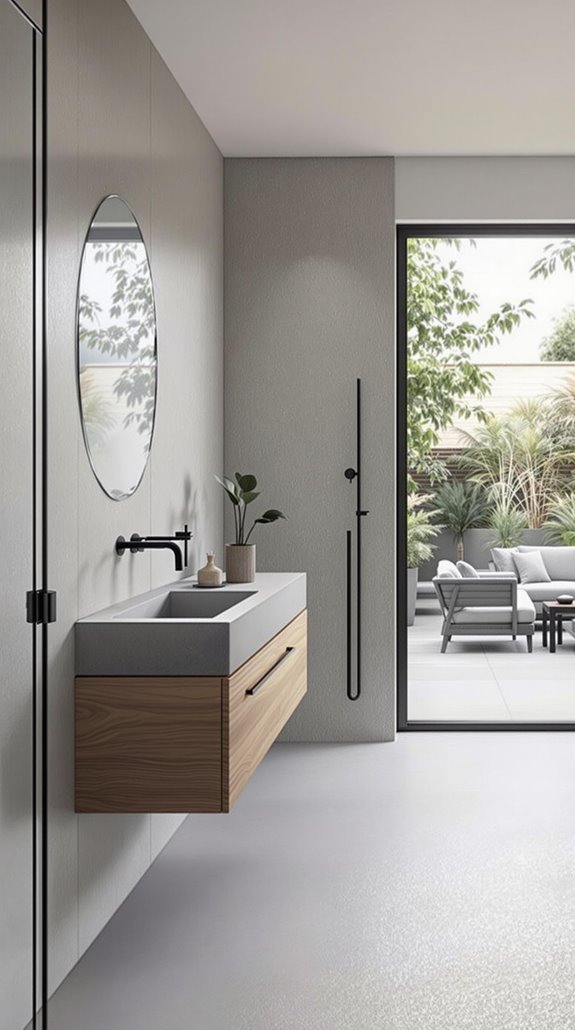
Since micro cement‘s molecular structure delivers exceptional durability, you’ll find its versatility transforms every space in your home—from moisture-heavy bathrooms to weather-exposed outdoor terraces. The process of applying micro cement can be simplified with proper planning permissions, ensuring a smoother renovation experience.
I’ve applied microcement over existing tiles in countless bathroom renovations, eliminating demolition debris while achieving that coveted polished concrete aesthetic. The 2-3mm application thickness means you’re using minimal material—perfect for our sustainability-focused community. At €60-€100 per m², you’ll save considerably compared to traditional tile replacement.
Your kitchen countertops and hallway floors benefit from the same seamless finish, creating visual flow throughout your space. I particularly love how it performs on outdoor terraces, where its waterproof properties and impact resistance handle UK weather conditions. The thin application reduces material waste while delivering professional results that connect your indoor and outdoor living spaces. The protective polyurethane varnish makes maintenance effortless, requiring only simple cleaning to preserve that fresh appearance.
Why Micro Cement Outperforms Traditional Renovation Methods
While traditional renovation methods force you to choose between demolition costs and design compromises, micro cement delivers superior performance across every metric that matters to your project. I’ve witnessed countless renovations where tiling requires extensive substrate preparation, grouting phases, and eventual maintenance headaches. Micro cement eliminates these pain points entirely.
You’ll apply just 2-3mm directly over existing surfaces—no demolition required. Where polished concrete demands heavy machinery and structural considerations, micro cement needs only basic tools. The seamless finish prevents the dirt accumulation that plagues grout lines, while stain-resistant properties reduce your long-term maintenance schedule. Additionally, using micro cement can significantly lower overall renovation costs compared to traditional methods.
Most importantly, you’re not locked into rigid geometric limitations. Curvilinear surfaces, complex geometries, and continuous applications become achievable without expansion joints or visible seams—something traditional methods simply can’t match. The skilled craftsmanship required ensures professional installation that maximizes both aesthetic appeal and long-term durability.
2025 Design Trends: Colours and Finishes Taking Centre Stage
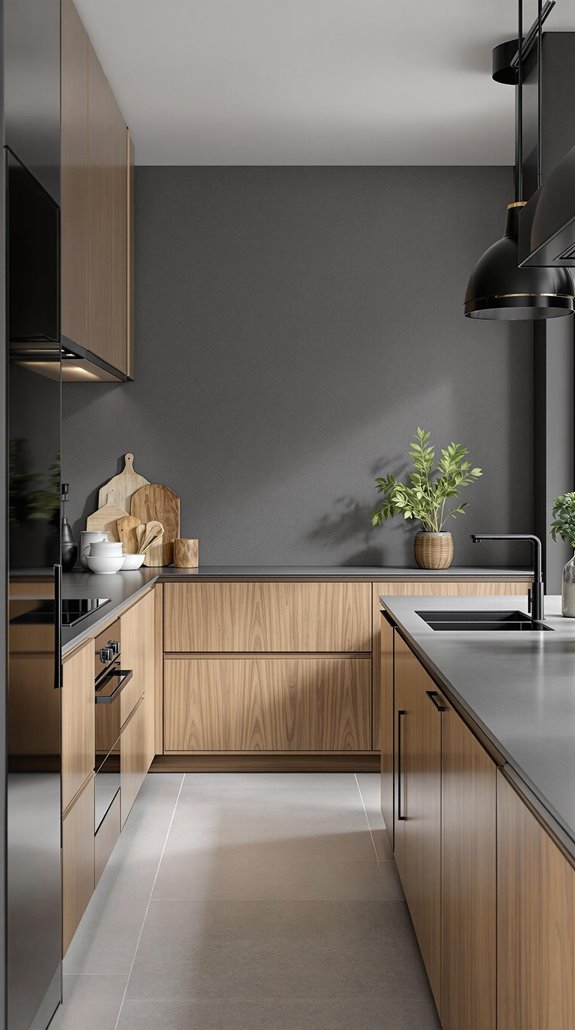
Five distinctive design trends are reshaping how you’ll approach micro cement specifications for your next renovation project.
Warm Neutral Dominance: I’m seeing beige, taupe, and soft terracotta replacing cooler greys in 2025 palettes. These shades create inviting spaces while maintaining seamless aesthetics.
Custom Color Flexibility: You’ll access 50+ shade options for bespoke finishes. This versatility enables exact décor matching across residential and commercial applications.
Minimalist Continuity: Joint-free surfaces across walls, floors, and ceilings maximize visual flow. The smooth texture enhances spaciousness in compact rooms. Textured finishes are increasingly complementing smooth applications to add character and create a handcrafted, bespoke feel.
High-Traffic Performance: Industrial-strength sealants withstand kitchen-living room merges where spills and frequent cleaning occur.
Eco-Conscious Installation: Low-VOC formulas and overlay applications reduce demolition waste while improving indoor air quality—perfect for sustainable renovation goals.
Professional Installation Vs DIY: Getting the Best Results
Achieving these on-trend micro cement finishes depends heavily on your installation approach—whether you tackle the project yourself or hire certified professionals. I’ve found that professional installation costs £50-£150 per square meter but delivers seamless results through expert epoxy application and proper surface preparation. Your DIY route reduces upfront expenses but demands meticulous attention to grinding, priming, and sealing phases—areas where mistakes create costly repairs later.
For complex projects, I recommend professionals who use industrial-grade equipment and brand-certified materials like Forcrete-approved systems. However, you can successfully handle smaller areas with curated DIY kits, proper tools including spreading trowels and sanders, and confidence in your technical skills. The key lies in honest assessment of your project’s complexity and your tolerance for iterative corrections.
Professional installations typically require five to seven days to complete, accounting for multiple layer applications and essential drying periods between each phase.
Cost Analysis: Long-Term Value of Micro Cement Investments
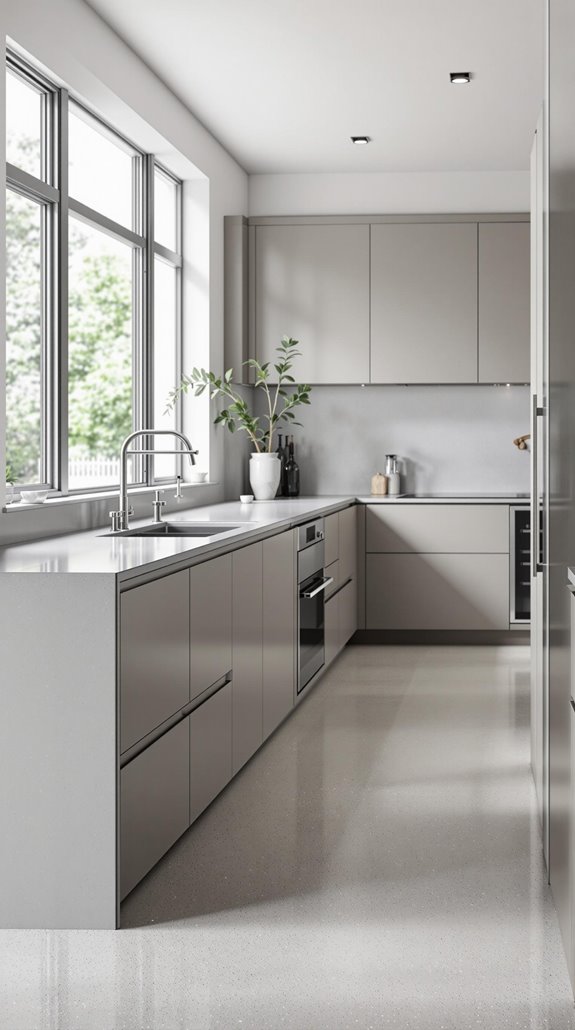
Because micro cement’s upfront costs often shock UK homeowners at £100-£180 per square meter, I’ll break down the financial reality that makes this investment worthwhile over time.
Your 25-year lifespan means you’ll slash maintenance costs by 50-70% versus tiles or wood. I’ve calculated that while you’ll pay 10-15% more initially than ceramic tiles, you’ll save 40% on lifetime costs compared to wood refinishing every five years. You’ll eliminate biennial regrouting expenses of £20-£50 per square meter entirely.
Here’s where smart project planning pays off: bulk installations over 50m² reduce costs by £15-£25 per square meter. You can cut professional fees by 15% through DIY substrate preparation. Your property value increases 5-7% through modern aesthetics, making this renovation investment both practical and profitable.
The multiple layers application process requires extended curing times, which means longer project durations but ultimately contributes to the superior durability that justifies the initial investment.
Safety Standards and Environmental Benefits for UK Properties
Safety compliance transforms your micro cement installation from a simple renovation into a professionally executed project that meets stringent UK regulatory standards. I’ll guide you through the essential safety protocols that protect both you and your property.
Your respiratory protection must comply with EN 149 standards, especially in high-dust environments. I recommend using ventilated areas during mixing to mitigate ammonium release. Apply skin protection cream before handling – it’s mandated, not optional. Keep containers tightly closed when not in use.
The environmental benefits make micro cement exceptional for UK properties. It’s non-combustible with no fire hazards, produces low VOC emissions, and shows no significant aquatic impact. Additionally, proper insulation can further enhance thermal efficiency in your home, leading to greater energy savings. Your floors achieve PTV ratings of 36+, ensuring commercial-grade slip resistance. The seamless surfaces require minimal cleaning effort, making maintenance straightforward for busy commercial environments. This isn’t just renovation – it’s responsible building that meets professional standards.
Maintenance Tips for Preserving Your Micro Cement Surfaces
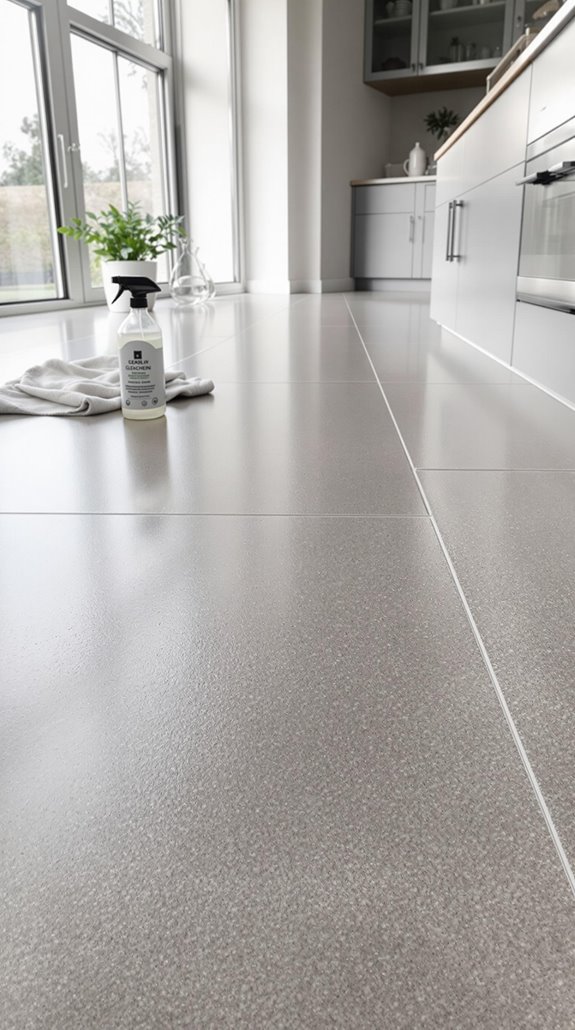
While micro cement surfaces deliver exceptional durability for UK renovations, they’ll only maintain their professional appearance through systematic maintenance protocols. I’ll guide you through the essential care techniques that preserve your investment.
First, establish a cleaning routine using pH-neutral detergents and microfiber cloths. You’ll want to address spills immediately—harsh chemicals like bleach will compromise your sealant layer. Regular sweeping prevents abrasive debris from scratching the surface.
Monitor moisture levels using calcium chloride tests, comparing results against manufacturer specifications. Install vapour barriers when readings exceed recommended thresholds, and improve ventilation to control ambient humidity. The 100% waterproof properties of micro cement make it exceptionally resistant to moisture damage when properly maintained.
For repairs, match your original microcement mixture precisely. Fill cracks promptly, sand smooth, and maintain consistent texture patterns. Place protective pads under furniture and use area rugs in high-traffic zones to prevent premature wear.
Conclusion
I’ve covered the technical specifications, installation methods, and project considerations that’ll determine your micro cement success. You’re equipped with the composition science, surface preparation requirements, and cost analysis tools needed for your renovation project. Whether you’re tackling a bathroom transformation or outdoor terrace upgrade, you’ve got the technical knowledge to evaluate contractors, select appropriate finishes, and maintain your investment. Your next step: source quality materials and begin surface assessment.
References
- https://www.microcementec.com/en/microcement-and-its-properties-an-versatile-material/
- https://www.imperaitalia.com/blogs/news/what-microcement-trends-can-expect-in-2025
- https://www.luxurylifestylemag.co.uk/homes-and-gardens/why-microcement-flooring-is-becoming-the-go-to-choice-amongst-luxury-homeowners/
- https://livingconcrete.co.uk/product/microcement-coating/
- https://clairedouglasstyling.co.uk/post/what-is-microcement
- https://www.ktcoatings.co.uk/documents/10-Benefits-of-Using-Microcement-in-Home-Renovations—KT-Coatings.pdf
- https://livingconcrete.co.uk/micro-concrete/
- https://topcret.com/en/microcement/
- https://www.ultimatehomeimprovement.co.uk/7-advantages-of-microcement-walls/
- https://www.surfacespec.co.uk/microcement

